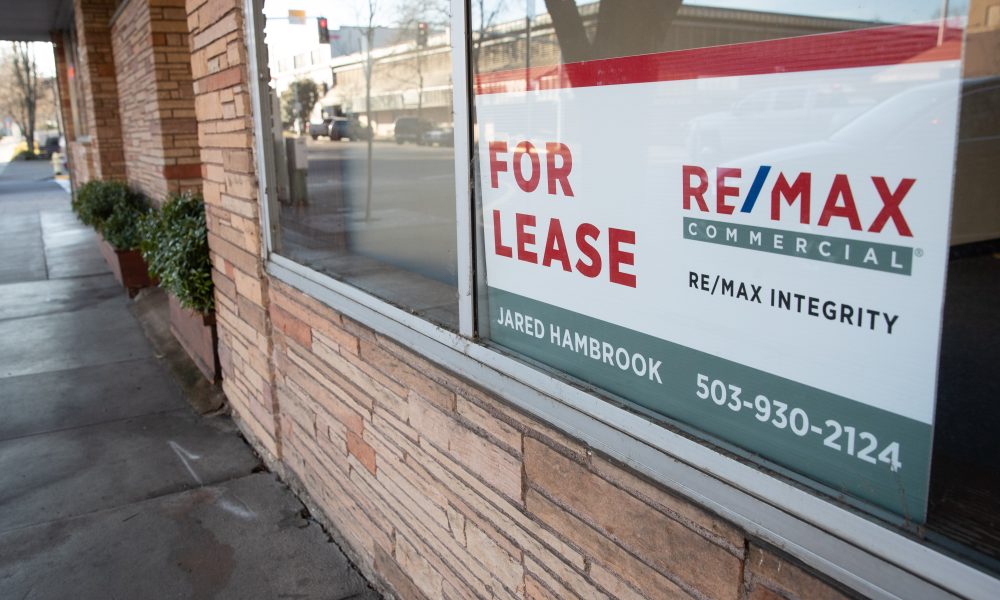Salem’s economy will be challenged by continued tightening in housing and a labor pool not large enough to meet employer needs, according to key Salem leaders.
Overall, most leaders surveyed by Salem Reporter expect the local economy to perform about the same or better than in 2022 but they see reasons for caution.
“Even though a lot of economic signs point to a weak 2023, most people are aware and moving forward with their life,” said Jose Gonzalez, owner of Tu Casa Real Estate and past president of the Latino Business Alliance. “Maybe the optimism comes from the fact we survived the Great Recession and the pandemic.”
Interest rates, which have climbed sharply in recent months, is a key factor to watch, some leaders said. Higher borrowing costs make it harder to buy a home or fund business operations.
“One of my greatest concerns is whether or not interest rates will continue to increase and the impact this would have on new development, new business startups as well as business financing for existing business and operations growth,” said Kristin Retherford, Salem urban development director.
Events overseas could ripple into Salem as well in the year ahead, according to some leaders.
“There continues to be a lot of uncertainty surrounding geopolitical events,” said Ryan Dempster, president of Willamette Valley Bank. “It will be interesting to see whether potential significant changes in relation to the war in Ukraine and/or economic conditions in other countries have a significant impact on the U.S. and local economy.
Every leader surveyed said housing would remain a significant challenge for Salem as home construction slows and rents increase.
“The market for new residential construction in Salem is likely to trend downward in 2023,” said Mike Erdmann, chief executive officer of the Home Builders Association of Marion and Polk Counties. “The construction of new homes dropped 36% in 2022 compared to the year prior, but most of that decline was in the latter half of the year when mortgage interest rates rose above 6%. With interest rates showing no signs of dropping substantially in the coming months, builders will continue to be more cautious about starting new construction projects without a buyer already lined up.”
Jimmy Jones, executive director of the Mid-Willamette Valley Community Action Agency, expects more families to be challenged to maintain their lifestyles.
“Rental market increases are going to make Salem increasingly unaffordable, exceeding the more modest increase in household incomes,” Jones said. “When families are rent burdened and spend too much of their total income on housing, energy, and food, other quality of life purchasing declines.”
Leaders had mixed assessments about the local labor market, with some seeing an easy in the shortage of workers while others expected businesses to face challenges filling jobs.
“Salem Health started 2023 with 636 open positions at all levels,” said Lisa Wood, Salem Health’s strategic communications administrator. “It’s a competitive market with both government and higher education employers competing for talent from a tapped market that is also struggling to fill entry-level, hospitality-based roles.
To gauge the year ahead for the local economy, Salem Reporter surveyed local leaders with written questions. Not all leaders surveyed participated. Here are their responses to the questions, edited for length.






The respondents:
Erik Andersson, president, SEDCOR
Ryan Dempster, president, Willamette Valley Bank
Mike Erdmann, chief executive officer, Home Builders Association of Marion and Polk Counties
Jose Gonzalez, owner, Tu Casa Real Estate; past president of the Latino Business Alliance
Jimmy Jones, executive director, Mid-Willamette Valley Community Action Agency.
Kim Parker-Leirenas, executive director, Willamette Workforce Partnership
Kristin Retherford, director, city of Salem urban development.
Tony Schacher, general manager, Salem Electric
R. Taylor, dean, Chemeketa Community College Business and Technology programs.
Lisa Wood, strategic communications administrator, Salem Health.
Q: Compared to 2022, how do you think Salem’s local economy will perform in 2023?
Andersson: While this answer will vary with each business and entrepreneur, SEDCOR generally sees more growth and investment coming in 2023. Partially, this is a result of long-gestating projects finally coming to fruition, and increased confidence in whatever a new normal is after the worst of the COVID pandemic. While inflation impacts may still be a major variable, some of the supply chain uncertainties have been addressed allowing for planned projects to go back on track toward implementation.
Dempster: I believe it is likely that we will enter a recession which will result in the Salem economy declining somewhat in 2023. Not only is inflation causing an increase in the cost for goods and services, the increasing interest rates results in higher borrowing rates. This not only impacts the housing market, but it also has an impact on vehicle purchases and the cost of borrowing money for other purposes. I feel that we have been able to weather the increasing rates due to business and household savings during the pandemic, but this money is now depleted and it will lead to an increase in unemployment and decline in discretionary spending.
Gonzalez: It will be the same or a little worse, just based on the actions and words of many of my clients/friends/family. Many are going to hold off on large purchases but are not thinking they will fare much worse.
Jones: For people in poverty, 2023 looks to be a tough year. Rising cost of living, increasing rental burden, limited access to childcare, public health, and medical services, especially mental health services, remain considerable barriers for people in poverty.
Parker-Leirenas: Although we keep talking about a pending recession, I’m not convinced it will happen. There have been some slowdowns in local manufacturing, but overall I don’t anticipate the local economy to change dramatically in 2023. It will be interesting to see how the hospitality industry continues to recover, and if we find individuals coming back into the labor market after taking as a result of the pandemic.
Retherford: City permit activity remains strong with continued interest in new development. I expected the local economy to perform slightly better in 2023 than in 2022.
Schacher: I feel that 2023 will see a bit of a slow down through the first half of the year. The main caveat is toward any new pandemic fears that might sideline growth later in the year.
Taylor: I anticipate a mixed picture. On the one hand, we see continued distance from the COVID-19 pandemic, leading to continued recovery. At the same time, continued challenges in the areas of labor, supply chain, and childcare that will continue to slow down growth, even in those areas where the market dictates otherwise. The impact of interest rates and market returns may also continue to be felt, especially in construction and infrastructure investment.
Q: In the year ahead, what do you consider the single most significant factor – such as housing, labor, interest rates – will have the most influence on Salem’s economy?
Andersson: In our conversations with employers in the region, labor availability is consistently mentioned as a major challenge. While SEDCOR generally works with “traded sector” businesses (e.g. manufacturers), I routinely see local retail and restaurant businesses also impacted, unable to keep their regular hours of operation due to labor. Many manufacturers are investing in new technologies and equipment to be able to increase production and efficiency without having to depend on finding new workers.
Dempster: Interest rates will have a significant impact on the economy as designed by the Federal Reserve. This will continue to have a significant impact on the housing sector and could lead to increasing unemployment.
Gonzalez: Housing related costs, home sale prices are not really dropping, and neither are rents. More people keep moving to Salem and we are in a housing deficit. I am not sure where we will have the supply we need.
Jones: For the public, housing costs will remain high and eviction numbers are likely to grow, as rental costs increase, eviction protections expire, and dedicated rental funds are spent down. For employers, this remains a very challenging labor market. Competitive and talented labor is expensive, and for workers this is absolutely still a buyer’s market.
Parker-Leirenas: Housing continues to be a huge struggle, whether it’s no housing, affordable housing, or access to housing. The market is softening, and that may lead to more availability, but housing (just like child care) have a direct impact on the workforce. If people can’t afford a place to live, they have a tough time working regular jobs.
Retherford: I think this is a tie between interest rates and labor. Housing starts will, in large part, be the result of interest rates and labor. Both of these factors present challenges to new development, business growth, and business expansion.
Schacher: Housing affordability and homelessness will go hand in hand. The market is still very tight and with interest rates increasing or even flattening the monthly mortgage payment is quickly getting out of reach for an average household if it wasn’t already.
Taylor: Although housing is clearly an urgent priority, I see labor and, more specifically, skilled labor, as the most significant factor.
Q: What business sector do you expect the grow the most?
Andersson: We grow nearly 200 crops in the three counties SEDCOR serves, and Salem sits in the heart of one of the most fertile valleys in the world. It’s been exciting to see growth in these sectors, and learn of opportunities for even more investment in the future. We also see great potential for smaller food products businesses and entrepreneurs, and look forward to providing some specific resources to help these businesses identify new markets and tools to serve them in 2023.
Dempster: I think most business sectors will struggle to grow during the year.
Gonzalez: Food production related, not retail food. Maybe better said as agriculture.
Jones: Housing construction will be a majority priority in the coming years. It will take years to hire the labor force and train the supportive systems to support the housing demand for the next twenty years.
Parker-Leirenas: Health care will continue to expand, and I’m optimistic behavioral health care will grow too. There’s an increased demand for behavioral health care workers. It will take years to get where we need to as a region, but the attention and discussion about this workforce is getting much-needed attention.
Retherford: The completion of a new hotel in downtown Salem this spring will provide a significant boost to the hotel/travel industry and result in this business sector seeing the most growth in 2023.
Schacher: State government.
Taylor: We will see continued growth in warehouse and distribution in our region.
I also think we will continue to see continued interest in entrepreneurship and small business starts across a variety of sectors.
Q: Employers struggled to hire in 2022. What is your assessment of Salem’s current labor pool?
Andersson: Salem benefits from not only its own diverse workforce, but also our employers are able to draw workers from Portland metro and Albany/Corvallis workforce markets. We are ortunate to have great workforce development partners and career technical education resources to skill up current and future workforce to meet the needs of local industry. Some employers are identifying new ways to attract and retain workers, such as seeking solutions for daycare and workforce housing challenges.
Dempster: I feel the local labor pool has stabilized somewhat. I have recently heard from employers that companies are receiving more applicants for open positions and the hiring process is becoming more competitive.
Gonzalez: Our labor pool is extremely tight. We compete with Portland area wages. Our hospitality industry is the hardest hit because the starting wages are close to the minimum wage.
Jones: We do not have a trained and experienced labor pool that a growing economy demands here in Salem. That’s not just the product of COVID, but of poor and underinvestment in education and employment training for decades. There is a “brain drain” of talented young people leaving for higher paying jobs outside of Salem. We need to begin to reverse that tide and invest in the training and career development of our community, and reward those folks with higher paying jobs so that they will choose to stay in Salem, live and raise their families here.
Parker-Leirenas: It hasn’t changed much over the last 12 months. What has changed is the supports and investment into training individuals, providing supportive services (gas cards, financial support for child care, rent, etc.) and attention on the need for individuals to have the training employers are demanding. This will take time to catch up to the demand, but I’m optimistic we will eventually have a more skilled labor pool in the region, and one that meets the needs of employers.
Retherford: I think Salem’s labor pool is consistent with what we are seeing round the nation. To Salem’s benefit, our labor pool extends to the Portland Metro Area, down to Eugene, over the coast, and up the canyon. Our access to a labor supply that extends far beyond city limits provides us with many more potential employees than live within City limits.
Schacher: It won’t get any better in 2023, many of the same issues we have seen in ’22 will continue to plague us, even when we get prospective candidates in good paying positions, they turn down the work because of Salem’s high cost of living.
Taylor: I see this as a challenge across all areas and from entry level to executive positions. From the lens of the educational institution, I see a large number of workers in the market who need to continue to skill up who are employed full time and lack the time, resources, or interest in traditional educational experiences. At the same time, employers need them to have more advanced skills. We also face a significant childcare challenge that will continue to impact the labor pool.
Wood: In years past, we saw entry-level workers hold more than one position just to make ends meet and, thus, filling many roles in the community; however, since the pandemic, hourly rates of pay have sky-rocketed, thus affording these workers the opportunity to scale back and hold just one job, essentially eliminating a good portion of the workforce while opening even more positions. Employers find themselves shuffling employees back and forth amongst each other and, from what we’ve observed, our rehire rates have increased. For our non-professional positions, we do fill locally, though time to fill has increased for these positions, and where we once received multiple candidates, we may receive just one or only a few. As with other industries, we have also observed that the pandemic has caused people to re-evaluate their feelings about work and we have seen both record numbers of retirements as well as a reluctance among others to re-enter the workforce.
Q: What one step could local government take to aid the Salem economy?
Andersson: I understand several communities along the I-5 corridor in the region are engaged in some type of industrial/commercial lands assessment to help ensure they have suitable land to accommodate future economic growth. I would like to see a multi-jurisdictional, cooperative approach to such planning efforts on a regional basis.
Dempster: Local businesses have proven their resiliency during the pandemic but they will be again feel the burden of a recession. Our local government can help us through this period by avoiding new taxes and continuing to find new ways invest in local projects.
Gonzalez: Share the vision that we are open for business and attract market share from the Portland area. In the real estate development area for example, common knowledge is Salem city government is unpredictable and difficult to navigate.
Jones: We need other sources of revenue generation to pay for the enormous social safety net that this community requires. Unlike Eugene and Portland, our revenue base in Salem is historically limited, and that’s depressed investment in the social safety net that can build a better long-term labor supply. Limited government has not protected our citizens from generational poverty.
Parker-Leirenas: Address the housing crisis. This impacts the economy and workforce in many ways.
Retherford: Continuing to develop and provide market tools, like incentives, and regulatory tools to support the development of both market rate and affordable housing is a very important action local governments can take to support the economy. This is necessary to attract and retain employees for our local businesses.
Schacher: Cut small business taxation, repeal the CAT tax, bring state employees back to their buildings.
Taylor: Supporting and expanding childcare businesses; work that would be best done across city and county boundaries.
Q: What one caution flag do you want to raise about the year ahead?
Andersson: As an exporting region in an exporting state, our local economy is extremely sensitive to international markets. While it can seem that the uncertainty of the situation in Russia, Ukraine or China is a world away, such issues very much impact the international markets on which many of our employers depend.
Dempster: There continues to be a lot of uncertainty surrounding geopolitical events. It will be interesting to see whether potential significant changes in relation to the war in Ukraine and/or economic conditions in other countries have a significant impact on the US and local economy.
Gonzalez: Only take on high-risk investments if you have the reserves to ride out whatever comes our way.
Jones: Rental market increases are going to make Salem increasingly unaffordable, exceeding the more modest increase in household incomes. When families are rent burdened and spend too much of their total income on housing, energy, and food, other quality of life purchasing declines. Folks end up making choices between buying food or buying gasoline. Paying for childcare, or paying their rent. This double bind of poverty, of making judgment calls between basic needs, prevents families from achieving self-sufficiency.
Retherford: One of my greatest concerns is whether or not interest rates will continue to increase and the impact this would have on new development, new business startups, as well as business financing for existing business operations and growth.
Schacher: The pandemic whisper has gotten a lot louder as of late with the opening of the Chinese public and economy and the rapid spread of the virus. If that sparks new fears by our elected officials they may make more bad policy calls and stymie any chance of pushing through a recession that we may have had.
Taylor: Recognize that we must change as the world around us changes.
What’s your view? Share your thoughts
We’re interested in your views about what you anticipate in Salem’s economy in the year ahead. Do you own a small business? Work for government? Work for local industry? Send your observations to Editor Les Zaitz by email: [email protected].

Les Zaitz is editor and CEO of Salem Reporter. He co-founded the news organization in 2018. He has been a journalist in Oregon for nearly 50 years in both daily and community newspapers and digital news services. He is nationally recognized for his commitment to local journalism. He also is editor and publisher of the Malheur Enterprise in Vale, Oregon.









